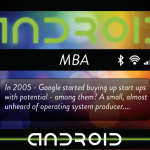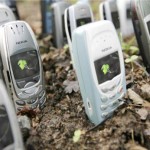Android, as an operating system primarily developed for smartphones is based on Linux kernel and developed by Google. Currently, android is the most popular OS used globally and as of June 2014, the Google Play store (android apps) has over 1.5 million applications and over 1 billion downloads. The journey for Android started in October 2003 with an intention to come up with an advanced user interface for digital cameras. However, when the developers realized that the usage of digital cameras isn’t large enough, the effort was shifted to smart phone platform. Since the first Android 1.0 (Alpha) and Android 1.1 (Beta), the operating system has been continuously improved and new features have come up with each new version. With the exception of the Alpha and Beta, Android versions were developed under confectionery themes and have been released in alphabetical orders.
The first confectionery version of Android was Android 1.5 (Cupcake) which came out in April 2009. Since them we have had 9 revisions to the Android OS namely Donut (Android 1.6), Éclair (Android 2.0-2.1), Froyo (Android 2.2-2.2.3), Gingerbread (Android 2.3-2.3.7), Honeycomb (Android 3.0-3.2.6), Ice Cream Sandwich (Android 4.0-4.0.4), Jelly Bean (Android 4.1-4.3.1), KitKat (Android 4.4-4.4.4) and currently the Lollipop (Android 5.0).
Android Lollipop
The latest version, Android 5.0 (Lollipop) was unveiled on June 25 this year with select devices like Nexus and the ones in the Google Play Edition would get the upgrade. The Lollipop has been the most ambitious release from Google so far. It comes with more than 5,000 new APIs for developers and has been designed to be highly flexible. The most striking aspect of the Lollipop version is the ‘Material Design’, presenting a consistent performance as you move from one screen to the other. Lollipop also seems to present you higher degree of control on the device and customizes your notifications and settings.
How is the Lollipop different from KitKat?
1. Design/Material: Android Lollipop seems to be the biggest change in years. Not only does android jumps into a full integer (5.0) but packed with several visual changes. Google like to call the improvement as “Material Design” reflecting bold and clean colors and lines that transform fun with animations. There is an exciting sense of depth to the interface. KitKat on the other hand was relatively flat and after working on the Lollipop, one would definitely go for the 5.0.
2. Notifications: While KitKat presented a static barrier for users looking to speed up their use, Lollipop presents more interactivity. With the new versions, notifications can be viewed as soon as you pick up your phone and messages can be responded to even with the lock screen.
3. API and Connectivity: Connectivity is again a big focus with Android Lollipop allowing users navigate more effectively with gestures, voice commands and more.
4. Security: Android Lollipop also integrated improved security features. An example would be the “geographical safe” zone where you need not enter the PIN to unlock the device.
5. Performance: What has been the optional runtime ART for KitKat is now the standard for Lollipop.
Introduction to Android One
Google creates a completely different segmentation for entry level smartphones with the Android One update. This puts both the developer and the end user at a convenient position when it comes to pricing. Android One has been released in India wherein new smart phone users can expect to experience Android L updates.
Android Lollipop vs. Android One
Android One is basically meant for cheaper handsets and first time smart phone users in India. In some months, it is expected that devices configured with Android One will also receive the Android Lollipop updates. This makes the world more interesting and intuitive for the buyers in the low price segment.
If you have any questions regarding this article or TheLocalBrand.com then please feel free to email us at support@thelocalbrand.com. We’ll answer your questions on branding and marketing if you submit here. Please Subscribe to our newsletter and don’t forget to follow us on Twitter and Facebook.
Latest posts by Linda Page (see all)
- Do we really need a new Candy again? : Android L - December 9, 2014
- Nokia: Memories of Good Old Days - November 20, 2014















